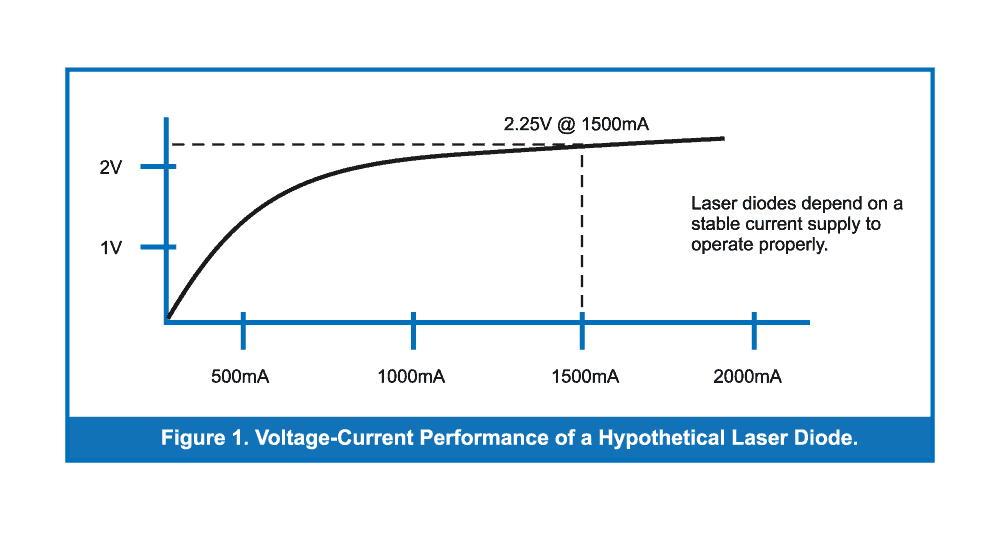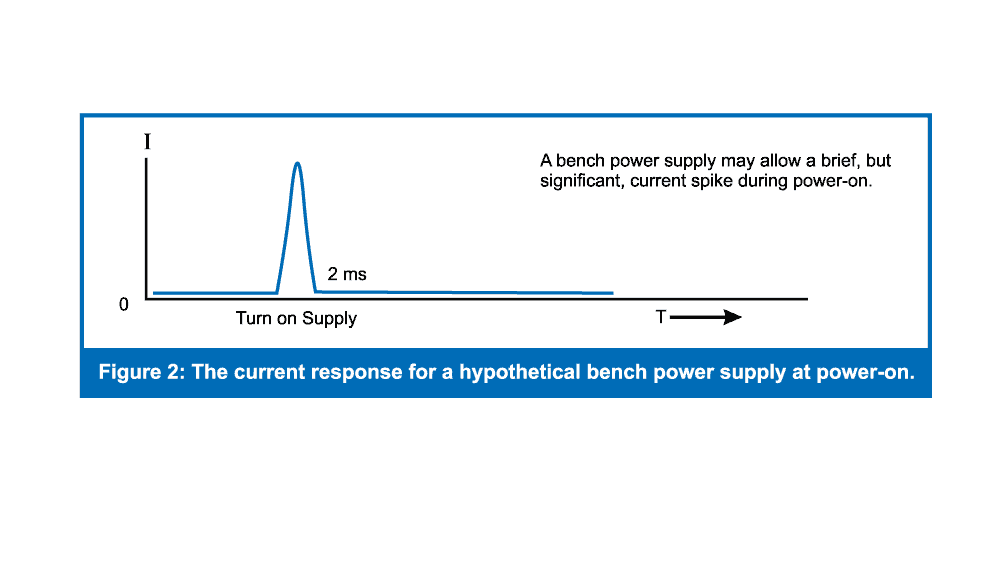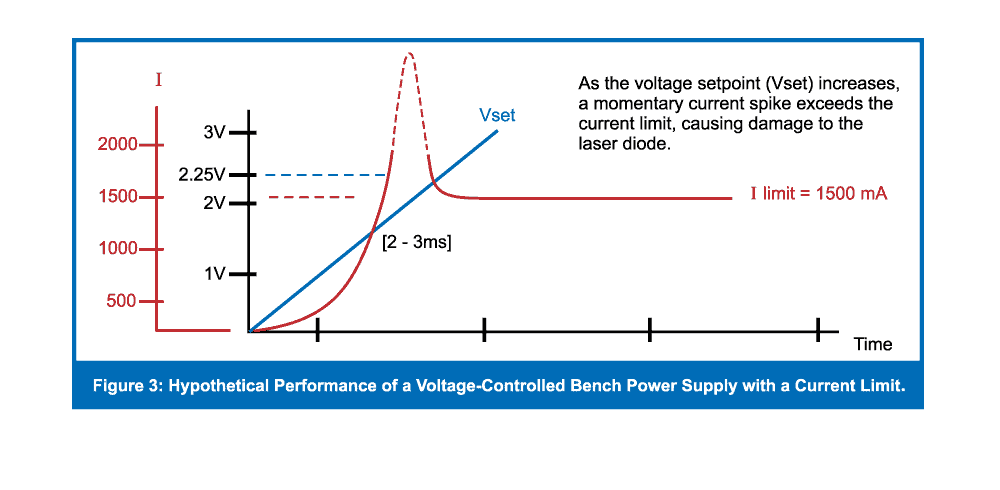Supplying power to a laser is delicate work. Your laser is extremely sensitive and easily damaged. A single pulse of excessive current, lasting only a few microseconds, can overheat and damage the light-emitting facets of a laser diode. A laser diode driver is always your safest and most effective method for powering a laser. The choice to use an alternative source, such as a bench power supply, should be carefully evaluated before proceeding. The answer depends on your application and on the performance of the specific bench supply in question.
A bench power supply should be thoroughly tested and characterized before you use it to power a laser. You will need to evaluate the quality of the controls and safety measures incorporated into a bench supply to determine whether it is suitable.
THE ISSUES OF BENCH POWER SUPPLIES
Issue #1 Dangerous Current Control
A laser diode is inherently a current-sensitive device, requiring constant current to function properly. Figure 1 shows the voltage-current performance of a hypothetical laser diode. The diode depends on a stable current control.

Figure 1 also shows that a small change in voltage can result in large changes in current. Never use a voltage controlled power supply.
Issue #2 Unpredictable Power-up
A bench power supply is unpredictable at start-up. Even with the voltage setpoint at zero, when you turn on the bench supply you may observe a brief, but significant, current spike. This spike, which has been measured at very amperage may only last a few milliseconds but is sufficient to cause critical damage to your laser. To operate safely, your laser diode requires a power supply that offers a slow turn-on, sometimes referred to as a “soft power-on.”

Issue #3 Slow Response Times
In response to Issue #2, some users may be tempted to turn on the bench supply at zero volts and let it stabilize before connecting the laser. In this circumstance, the circuit is open before the laser is
connected. Even though the voltage setpoint is at zero, there will typically be a small voltage present. As you complete the connection to the laser, the current may spike rapidly as the supply reacts to the nearly zero impedance load. The bench supply will respond by bringing the voltage back to the nearly zero setpoint you indicated, but that response will not be fast enough to protect your laser.
Issue #4 Limited Voltage and Current Safeguards
The only remaining option would be to connect the laser to the bench supply with the voltage and current setpoints at zero. Assuming that the bench supply did not allow a current spike at power-up, the subsequent increase in voltage and current still have an inherent risk. A bench supply is not typically designed to make the transition from voltage control to current control with the necessary speed and may fluctuate enough to damage your laser. Even bench supplies with current limits will typically not be sufficiently fast to protect the laser in an over-current situation.

In Figure 3, we see the performance of a hypothetical bench power supply that is voltage controlled. This power supply only allows us to set a maximum current limit (I limit = 1500 mA). As we increase the voltage, Vset, we see a momentary current spike that exceeds the current limit. The bench power supply eventually corrects this current spike, but by the time it does, the damage to the laser diode is already done.
Issue #5 Other Missing Safeguards
Other safeguards that will almost certainly be missing from bench supplies include:
- Intermittent contact safeguards: If you have intermittent contact, such as a bad cable, many bench supplies will exceed their current limit by a significant margin when the connection is restored. The power source you use for your laser should have a built-in safety feature to guard against faulty cables.
- Over-voltage protection: Your laser power source should shut down when voltage exceeds a preset limit.
- Shorting protection: Once powered down, the supply should use a relay to short the leads of the laser, to prevent a voltage potential from building across the laser device.
- Other engineered protections, such as safe shutdown on AC power failure and electrical isolation should also be included.
CHARACTERIZING THE PERFORMANCE OF A BENCH POWER SUPPLY
To characterize a bench power supply you will need equipment capable of measuring fast voltage and current transients while minimizing the impact on the supply performance while making these measurements.
A common practice for current measurement is to place a non-inductive current sense resistor in series with the supply and measure the voltage across the resistor. From this you can derive the current. However, adding a series resistor can change the dynamics of the loop and give you a different (and therefore not accurate) picture of the supply performance. A better choice is to use a non-contact DC current probe, such as a Tektronix TCP202, to measure current flow, which does not change the dynamics of the control loop and therefore does not influence the measurement. In either case, you will need an oscilloscope of at least 300 MHZ bandwidth to be able to capture any transient events. If using the current sense resistor, because the ground of the scope is often earth ground, you should float the oscilloscope by disconnecting earth ground from the oscilloscope using a ground lift plug.
Another consideration is the load to be used during testing. Obviously, you do not want to use the laser itself… the whole point is to ensure the supply is safe to use with the laser. You can approximate a laser by using high speed rectifier diodes, with a sufficient number of diodes in series to develop the same operating voltage as your laser. Make sure to select rectifier diodes with sufficient current handling and heat sink the devices as necessary. You will then need to simulate the various operating conditions to which the bench supply will need to respond. Begin by connecting a load to your power supply. Measure the current performance in the following scenarios, along with any others that may be relevant:
- Turn the power supply on and off several times.
- Start the circuit in an open condition and then close the circuit.
- Move from one voltage and current setpoint to the next.
- Test an intermittent connection, such as that caused by a loose cable.
- If your power supply accepts a function generator input, test the performance of the bench supply while connected to the function generator.
- If the bench supply performs adequately under these circumstances, it may be suitable for your laser application.
WHEN ARE BENCH SUPPLIES APPROPRIATE FOR LASERS?
In any case, careful characterization of your power supply is of the utmost importance to reduce the risk of laser damage. Ultimately, your best option may be to use a laser diode driver. A laser driver will include a variety of safeguards specific to operating a laser. Even the most inexpensive laser driver will offer superior protection, higher accuracy, and better performance than a bench power supply.
LASER POWER SUPPLY FEATURE CHECKLIST
You can use this easy checklist to verify the laser diode driver you purchase has all of the features you need:
- Optical Isolation for Inputs & Control Circuitry
- Computer connectors (USB, RS-232, GPIB, etc.)
- Modulation input
- Photodiode input
- Free-Floating Anode & Cathode
- Soft Turn-On
- Accurate, Stable Current Control
- High-Speed Voltage Limit
- Intermittent Contact Safeguard
- Current Limiting
- Optical Power Feedback Control
- Low Noise
Arroyo Instruments laser diode drivers include every one of these features. For help choosing the right power source for your laser, or for advice on your application, contact us anytime, by phone or email.
Evaluating A Bench Power Supply As A Laser Current Source (PDF Version)